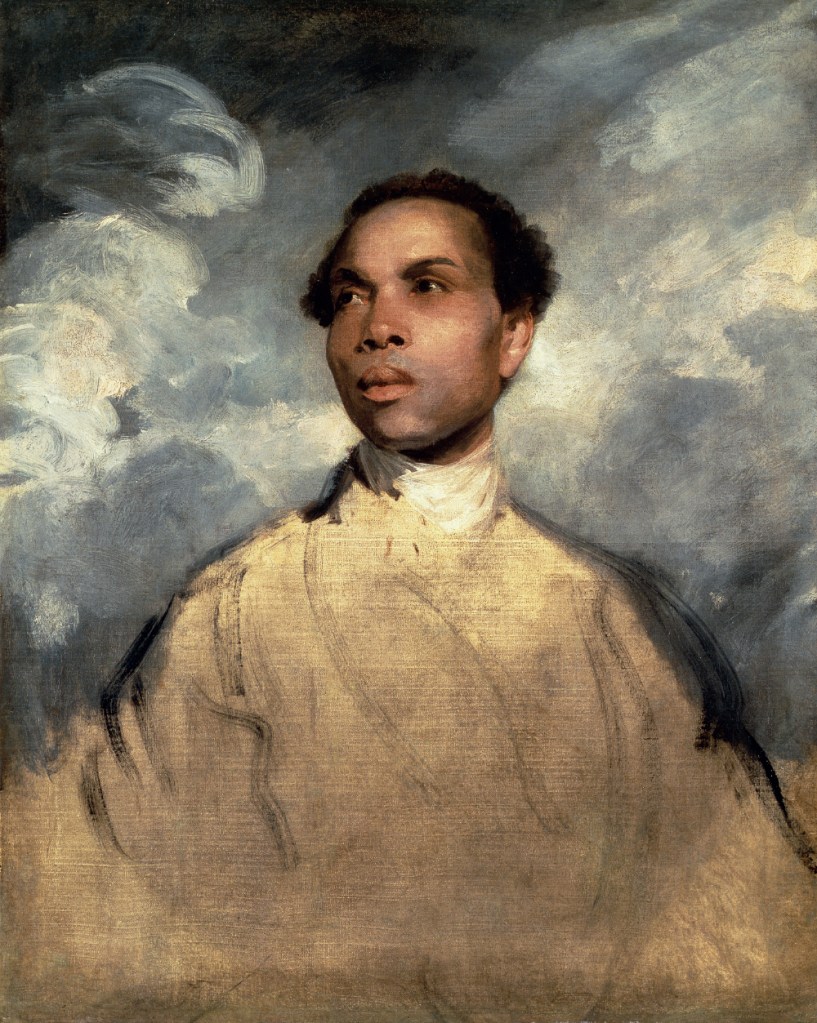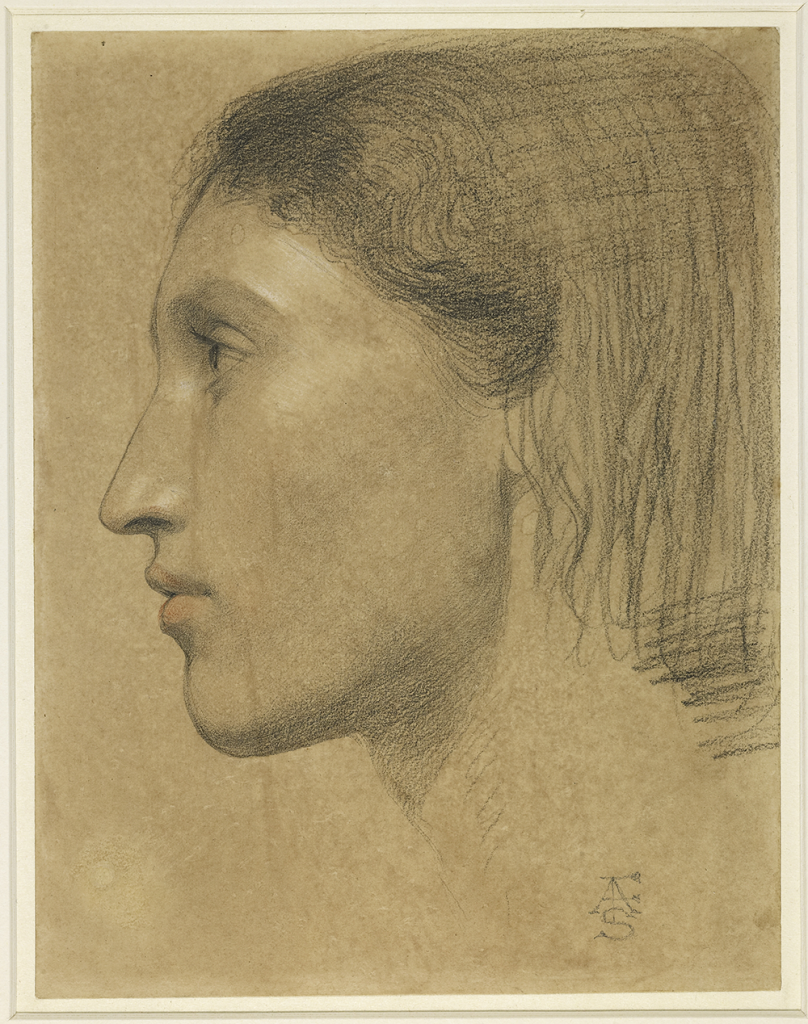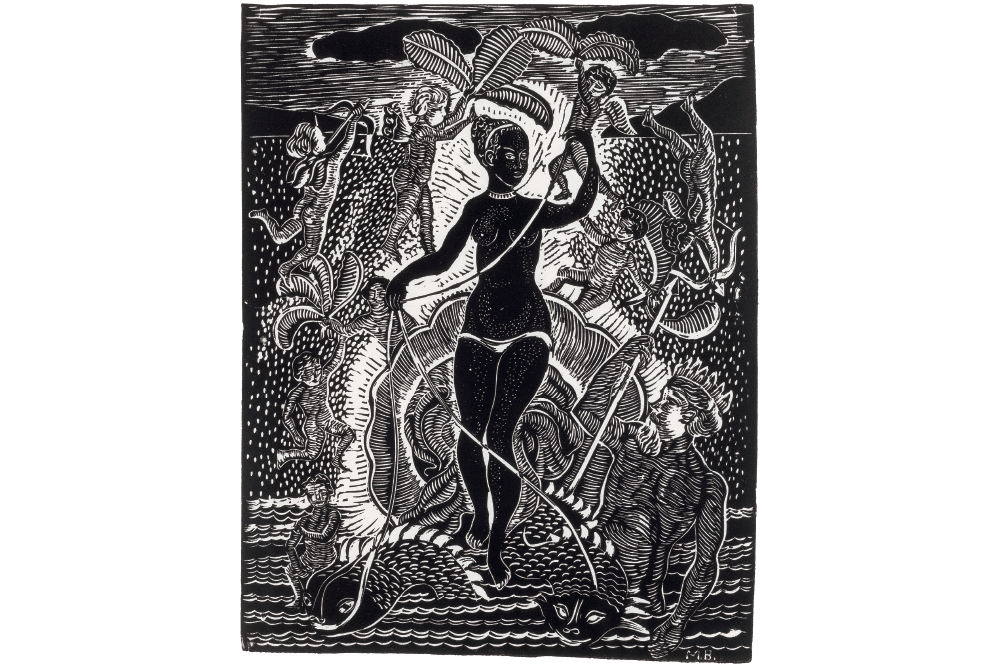In the wake of the Fitzwilliam Museum’s exhibition Black Atlantic about its founder’s ties to the slave trade comes the Royal Academy’s Entangled Pasts, less of a mea culpa than an examination of conscience by an institution which, although hailed by its first president Sir Joshua Reynolds as an ‘ornament’ of Empire, was innocent of direct links to slavery.
The exhibition is less of a mea culpa than an examination of conscience
I confess that I was rather dreading this show, which sounded from the pre-publicity like a hollow exercise in Britannia-Rules-the-Waves breast-beating, but from the moment I stepped into the courtyard and saw the posturing Sir Joshua on his plinth upstaged by Tavares Strachan’s life-sized ‘The First Supper (Galaxy Black)’ (2023) – a riotous gathering of black luminaries in bronze and gilt – I realised my mistake. Since the election of Frank Bowling as the first black member of the RA in 2005, the Academy’s ranks have been swelled by artists of Caribbean, African and South Asian descent who have something to say about Empire other than ‘sorry’, and they set the tone for this exhibition. It’s not about raking over the past: it’s about colonialism, but also about change.
It starts from small beginnings in the octagon, hung with examples of the few historic portraits of black sitters, some named, such as Britain’s first black voter, the former slave and man of letters Ignatius Sancho in Gainsborough’s 1768 portrait, others nameless, such as the models for Francis Harwood’s classical ‘Bust of a Man’ (1758) – an emperor without a toga – and John Singleton Copley’s vivid oil sketch,‘Head of a Man’ (1777-78).
The Boston-born Copley is the only Royal Academician known to have owned slaves and the model for the black sailor in his contemporary history painting ‘Watson and the Shark’ (1778) may have been one of them. Reynolds had a black servant who may have modelled for the valet tightening the belt of the portly and profligate ‘George IV as Prince of Wales’ (1787). We don’t know his name, but we do know the identity of the black servant smilingly feeding grapes to Richard Cosway RA and his wife dressed as Mr and Mrs Rubens in a 1784 etching by Thomas Rowlandson: Ottobah Cugoano, former slave and author of the influential abolitionist pamphlet Thoughts and Sentiments on the Evil and Wicked Traffic of Slavery and Commerce of the Human Species (1787), to which Reynolds subscribed.
By the late 18th century London’s black population was more than 10,000, but black faces were still unfamiliar enough to cause alarm to the white-skinned child in William Mulready RA’s ‘The Toy Seller’ (1857-63). Artists, on the other hand, relished the chance to experiment with skin tones. Edwin Long RA’s Victorian fantasy of a ‘Babylonian Marriage Market’ (1875) is an animated colour chart, but not all depictions of black people were generic. There’s a wonderfully sensitive chalk study (c. 1859-60) by Frederick Sandys of Fanny Eaton, a mixed-race model of Jamaican heritage popular with academicians for biblical subjects.

A page listing Eaton’s sittings has been dug out of the Academy’s archives, along with an attendance table of 1830 registering the School’s first black student, the Jamaican-born animal painter William Morrison Brown, none of whose paintings have been identified. Disappearing from the historical record is an occupational hazard of being an artist irrespective of colour, but losing your identity in your own lifetime is another matter. The carnivalesque cut-outs of plantation slaves in Lubaina Himid RA’s two-room installation, ‘Naming the Money’ (2004), have been allotted European names according to their trades; their African birth names are recorded on invoices glued to their backs.
The scale of the contemporary works dwarfs the historic. Copley’s ‘Watson and the Shark’, celebrating the heroic true-life rescue of a British merchant seaman from a shark in Havana harbour, the sensation of the 1778 exhibition, appears diminished when seen through the forest of masts of Hew Locke RA’s model ‘Armada’ (2017-19) of colonial craft, suspended on wires as if floating on a sea of air. The maritime theme culminates in a gallery focused on the Middle Passage, from which J.M.W. Turner’s ‘The Slave Ship’ (1840) – stuck in Boston – is a glaring omission. Displaying the artist’s contemporary ‘Seascape with Buoy’ (1840) and ‘Whalers’ (c. 1845) doesn’t fill the gap; they could at least have included a reproduction.

The most powerful image of watery resilience is the simplest: a Black Venus
Turner’s ‘Slave Ship’, the object of ridicule when first unveiled at the Academy weeks after a London meeting of the World Anti-Slavery Convention, was the inspiration for Bowling RA’s fiery ‘Middle Passage’ (1970) and a key influence on Ellen Gallagher’s ongoing ‘Watery Ecstatic’ series, imagining a Black Atlantis peopled by the descendants of pregnant slaves thrown overboard during the Atlantic crossing. The theme of black humanity reborn from the waves is echoed in Kara Walker’s etching ‘no world’ (2010), in which a giant pair of black hands holds the silhouetted form of a Baltimore clipper – a favoured means of transport for perishables, including slaves, because of its speed. But the most powerful image of watery resilience is the simplest. In the early 1950s the black American educator and artist Margaret Burroughs took a sabbatical from teaching in Chicago to study revolutionary printmaking in Mexico. Her ‘Black Venus’ (1957) takes the jingoistic imagery of Thomas Stodhart RA’s ‘Voyage of the Sable Venus from Angola to the West Indies’ (1794), with its dusky beauty riding in a scallop-shell chariot attended by a sea god holding a Union Jack, and manages to completely subvert it by ditching the flag and translating the soft-focus into stark black and white. ‘Slave masters,’ Burroughs later wrote in explanation, ‘selected the most beautiful of the virgin black slave women for their own personal use. And yet these women survived to become mothers of a nation.’
I often beef about lengthy videos in exhibitions, but it’s worth seeing John Akomfrah RA’s three-screen ‘Vertigo Sea’ (2015), an eclectic meditation on ‘the aquatic sublime’ that weaves together excerpts from David Attenborough’s Blue Planet and footage of whalers, polar bear hunters and hornpipe-dancing sailors with staged shots of black actors washed up as bodies on beaches or posing as Romantic Rükenfiguren staring out to sea. With a soundtrack mixing the cries of gulls with the strains of ‘Un bel di, vedremo’ from Madama Butterfly, it’s an immersive experience. I stumbled out onto Piccadilly with vertigo. The message of this show? It’s complicated.
Entangled Pasts 1768-now: Art, Colonialism and Change is at the Royal Academy of Arts until 28 April.






Comments